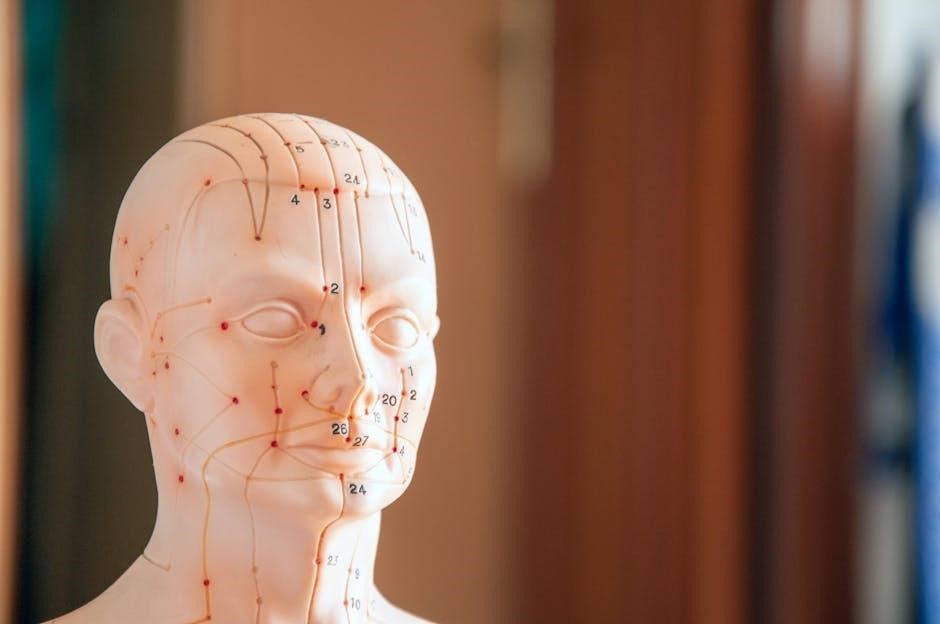TENS Electrode Placement Chart PDF: A Comprehensive Guide
This comprehensive guide offers a handy TENS unit placement chart. Use it as a reference. It guides you when placing electrodes on your body for pain relief treatments. Consult a professional for assistance!
Understanding TENS Therapy
TENS, or Transcutaneous Electrical Nerve Stimulation, is a therapy employing a device that delivers electrical pulses across the skin to stimulate nerves. It’s commonly used for pain management. These electrical pulses can help reduce pain signals traveling to the brain and may also stimulate the body to produce its own natural painkillers, called endorphins.
Understanding how TENS therapy works is crucial for effective pain relief. The therapy’s success depends on factors like the intensity and frequency of the electrical stimulation, as well as the precise placement of the electrodes. Different electrode placements can target specific pain areas. It is important to note that TENS therapy does not cure underlying conditions, but manages the symptoms.

Basics of TENS Units and Pain Relief
TENS units offer valuable, cost-effective pain relief. Proper electrode placement is vital for optimal results. Charts help guide placement. TENS manages pain by stimulating nerves with electrical pulses, offering alternative pain management.
How TENS Units Work
TENS units deliver small electrical impulses through electrodes placed on the skin. These impulses target nerves, aiming to reduce pain signals reaching the brain; The precise mechanism isn’t fully understood, but theories suggest several possibilities.
One theory proposes that TENS stimulates the release of endorphins, the body’s natural painkillers. These endorphins then interfere with pain perception. Another theory suggests that TENS blocks pain signals through the “gate control theory.” This theory posits that non-painful input can close the “gate” to painful input, preventing pain sensations from traveling to the brain.
Furthermore, TENS may improve circulation and reduce muscle spasms, contributing to pain relief. The effectiveness of TENS can vary depending on the individual, the condition being treated, and the proper placement of electrodes. Experimentation and professional guidance are often necessary to find the optimal settings and electrode positions for maximum pain relief. TENS is often used as an industry leading alternative pain management device;
Importance of Proper Electrode Placement
Proper electrode placement is vital for optimal TENS unit results. Correct placement ensures targeted stimulation. This maximizes pain relief. Always apply electrodes to the site indicated by a professional.
Maximizing Pain Relief with Correct Placement
To effectively maximize pain relief using a TENS unit, proper electrode placement is paramount. The specific placement directly influences the unit’s ability to target the affected nerves and muscles, delivering therapeutic stimulation. Consulting placement charts and guides ensures accurate positioning for various conditions like neck pain, lower back pain, or sciatica.
Incorrect placement may result in reduced pain relief or even discomfort. Electrodes should be positioned around the pain site, either parallel or crisscrossed, following the guidelines provided by healthcare professionals or TENS unit manuals. Some placements focus on stimulating specific nerve pathways, while others target broader areas of muscle tension.
Experimentation may be necessary to find the most effective placement for individual pain experiences, but always adhere to safety guidelines. Correct placement, coupled with appropriate intensity settings, is key to achieving optimal pain management with a TENS unit. Remember to clean and prepare the skin before application.

General Guidelines for Electrode Placement
Proper electrode placement is vital for optimal TENS unit results. Consult charts to guide you. Apply electrodes to the exact site indicated by a professional after cleaning and drying the skin.
Skin Preparation and Electrode Application
Prior to TENS unit electrode application, proper skin preparation is crucial for optimal conductivity and adhesion. Begin by ensuring the skin at the application site is clean and dry. Use mild soap and water to remove any oils, lotions, or dirt that may impede electrode contact. Thoroughly dry the area with a clean towel.
For individuals with excessive hair at the chosen site, consider trimming or shaving the hair to facilitate better electrode adherence and prevent discomfort during removal. Once the skin is prepared, carefully peel the electrodes from their backing, preserving the adhesive gel.
Position the electrodes according to the recommended placement chart or guidance from your healthcare provider. Firmly press the electrodes onto the skin, ensuring full contact and minimizing air pockets. Secure the lead wires to the electrodes, taking care to avoid pulling or straining the connection. After the session, gently remove the electrodes. Inspect the skin for any irritation.
Specific Placement Charts for Common Conditions
Proper electrode placement is vital for optimal TENS unit results. The following charts offer guidance. These charts were prepared to help with specific conditions. Follow them for the best pain relief.
Neck Pain Electrode Placement
For effective neck pain relief, strategic electrode placement is crucial. Position two electrodes on either side of your spine, high on your neck, just beneath the skull. This placement targets the muscles often responsible for tension and pain in the upper neck region.
Follow this by placing the other two electrodes lower down the neck, ensuring they are also positioned on either side of the spine. This configuration creates a broader field of stimulation, encompassing more of the affected area. Ensure the skin is clean and dry before application.
Experiment with slight adjustments to find the most comfortable and effective position. If pain persists, consult a healthcare professional for personalized guidance on TENS unit usage and electrode placement tailored to your specific condition and needs, ensuring you achieve the best possible outcome.
Lower Back Pain Electrode Placement
Effective lower back pain relief with a TENS unit hinges on proper electrode placement. A common approach involves placing electrodes parallel to the vertebral column, also known as paraspinal application. This allows stimulation of the tissues surrounding the spine, targeting muscle spasms and nerve irritation.
Positioning electrodes over the intervertebral foramen, the openings where nerves exit the spinal cord, can also prove beneficial. This targets nerve roots directly. For unilateral pain, place electrodes on the affected side. For bilateral pain, use a symmetrical placement on both sides of the spine.
Experiment with slight variations to find what works best for you. If pain radiates down the leg, consider adjusting electrode placement to include the sciatic nerve pathway. Remember, consulting a healthcare professional can provide tailored guidance for your specific condition.
Sciatica Pain Electrode Placement
Sciatica, characterized by pain radiating down the leg, requires a strategic TENS electrode placement. Begin by identifying the origin of the sciatic nerve in the lower back. Place one electrode pair along the lower back, near the spine, at the point where the pain originates.
The second electrode pair should be positioned along the path of the sciatic nerve in the leg. This could be on the back of the thigh or calf, depending on where the pain is most intense. Ensure the electrodes are placed on clean, dry skin for optimal adhesion and conductivity.
Experiment with different placements along the nerve path to find the most effective configuration for your individual pain pattern. A diagonal placement, following the nerve’s trajectory, can also be beneficial. Always start with low intensity and gradually increase it until you feel a comfortable tingling sensation.

TENS Electrode Placement: Safety and Precautions
Prioritizing safety with TENS unit use is paramount. Always consult a healthcare professional before starting TENS therapy, especially if you have underlying health conditions or use implanted medical devices. Never place electrodes over the heart, brain, eyes, or open wounds.
Ensure the skin is clean and dry before applying electrodes to prevent irritation. Do not use TENS units while driving, operating machinery, or in the shower. Start with the lowest intensity setting and gradually increase it to a comfortable level. Avoid prolonged use at high intensities.
If you experience skin irritation, discontinue use and try hypoallergenic electrodes. Regularly inspect electrodes for damage and replace them as needed. Keep the unit and electrodes out of reach of children and pets. Follow all manufacturer instructions carefully to ensure safe and effective pain relief.

Troubleshooting Common Issues with Electrode Placement
If you’re not experiencing pain relief with your TENS unit, improper electrode placement is often the culprit. First, ensure the electrodes are firmly attached to clean, dry skin. Check for worn or damaged electrodes and replace them.
Experiment with slightly different placements, referring to a TENS electrode placement chart for guidance. If the stimulation feels weak or uneven, try adjusting the intensity settings or switching to a different waveform. Ensure the lead wires are securely connected to both the electrodes and the TENS unit.
If you experience skin irritation, consider using hypoallergenic electrodes or applying a skin protectant. If the problem persists, consult your healthcare provider. They can assess your placement and settings, and rule out any underlying issues. Remember, optimal electrode placement can vary, so patience and experimentation are key.
